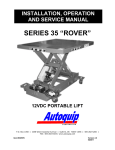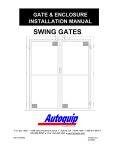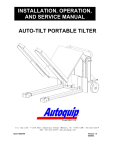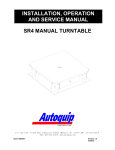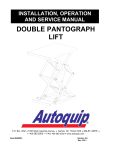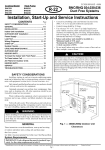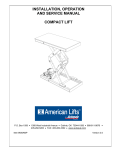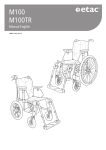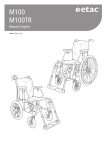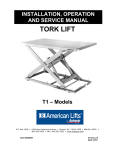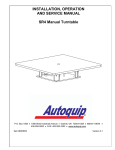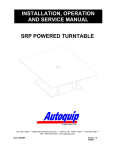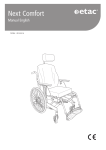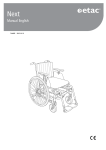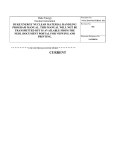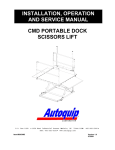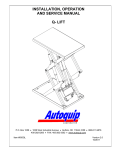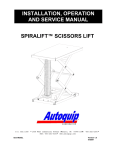Download Mechanical Lift - Autoquip Corporation
Transcript
INSTALLATION, OPERATION AND SERVICE MANUAL MECHANICAL SCISSORS LIFT P.O. Box 1058 • 1058 West Industrial Avenue • Guthrie, OK 73044-1058 • 405-282-5200 • FAX: 405-282-8105 • www.autoquip.com Item # 830LA Version 1.0 09/2001 TABLE OF CONTENTS Identification and Inspection 3 Dangers and Warnings 4 Label Identification 8 Specifications 11 Lift Blocking Instructions 12 Installation Instructions 14 Operating Instructions 17 Routine Maintenance 18 General Maintenance 19 Replacement Parts List 21 Troubleshooting Analysis 22 IMPORTANT Please read and understand this manual prior to installation or operation of this lift. Failure to do so could lead to property damage and/or serious personal injury. If any questions arise, call a local representative or Autoquip Corporation at 1-888-811-9876 or 405-282-5200. PLANNED MAINTENANCE PROGRAM A local Autoquip representative provides a Planned Maintenance Program (PMP) for this equipment using factory-trained personnel. Call a local representative or Autoquip Corporation at 1-888-811-9876 or 405-282-5200 for more information. 2 IDENTIFICATION & INSPECTION IDENTIFICATION When ordering parts or requesting information or service on this equipment, PLEASE REFER TO THE MODEL AND SERIAL NUMBER. This information is on a nameplate attached to the leg assembly. Replacement parts are available from a local Autoquip distributor. INSPECTION Immediately upon receipt of the unit, a visual inspection should be made to determine that it has not been damaged in transit. Any damage found must be noted on the delivery receipt. In addition to this preliminary inspection, the unit should be carefully inspected for concealed damage. Any concealed damage found that was not noted on the delivery receipt should be reported in writing to the delivering carrier within 48 hours. The following is a checklist that will aid in the inspection of this equipment. 1. Examine the entire unit for any signs of mishandling. 2. Pay special attention to gearboxes, mechanical actuators & wiring. 3. After installation, raise and block the lift and inspect the base frame, scissors assembly and mechanical drive system. See the “Lift Blocking Instructions” section. 3 DANGERS, WARNINGS & CAUTIONS SAFETY ALERTS (Required Reading!) The following SAFETY ALERTS are intended to create awareness of owners, operators, and maintenance personnel of the potential safety hazards and the steps that must be taken to avoid accidents. These same alerts are inserted throughout this manual to identify specific hazards that may endanger uninformed personnel. Identification of every conceivable hazardous situation is impossible. Therefore, all personnel have the responsibility to diligently exercise safe practices whenever exposed to this equipment. ____________________________________________________________ DANGER! Identifies a hazardous situation that presents the imminent probability of death or of severe personal injury!! _____________________________________________________________ WARNING! Identifies a hazardous situation that has the potential of causing death or serious personal injury. CAUTION! Identifies a hazardous situation that could lead to the possibility of personal injury of death, and/or may result in equipment damage. _____________________________________________________________ 4 DANGERS, WARNINGS & CAUTIONS Read and understand this manual and all labels prior to operating or servicing the scissors lift. All labels are provided in accordance with ANSI Z535.4. DANGER! Do not work under lift without Maintenance Device! To avoid personal injury, NEVER go under the lift platform until the load is removed and the scissors mechanism is securely blocked in the open position. See "Lift Blocking Instructions" section. DANGER! To avoid personal injury, stand clear of scissors mechanism while the lift is in motion. DANGER! Do not install the lift in a pit unless it has a bevel toe guard or other approved toe protection. A shear point can exist which can cause severe injury to the foot. DANGER! HIGH VOLTAGE!! Disconnect and/or lock out the electrical supply to the power unit prior to any maintenance being performed. 5 DANGERS, WARNINGS & CAUTIONS DANGER! Scissors lifts are designed individually for a specific load and application. To avoid personal injury, do not change the load or application from the original design. WARNING! NEVER stand, sit or ride on the lift! WARNING! All warning and information decals should be in place as outlined in the “Label Identification” section. If decals are missing or damaged, they should be replaced with new ones. Contact Autoquip for replacements. WARNING! Do not attempt to remove the drive mechanism until the maintenance locks securely support the empty lift. Failure to do so could results in personal injury or death! WARNING! Lift platforms traveling below floor levels may create openings, and the shape of the load and how the load is arranged on the lift may create a toe hazard as the load passes the top edge of the pit. Both situations may require guarding in accordance with Federal Regulations. Any such guarding must be installed prior to operating the lift. . 6 DANGERS, WARNINGS & CAUTIONS CAUTION! When moving the lift, do not attempt to pick it up by the platform; it is hinged and could be damaged. Pick up from under the base frame ONLY. CAUTION! Do not continue to activate the “UP” button if the lift is not raising or if it has reached the fully raised position. To do so may result in permanent damage to the lift. CAUTION! Precautions should be taken to prevent the introduction of contaminates such as dirt or other foreign material into the drive system through open fittings, pipes or disassembled components. Contamination will ruin the drive mechanism. 7 LABEL IDENTIFICATION 2 3 1 4 5 Figure 1 Label Placement Diagram Mechanical Lift Item No. Qty Description 1 2 Danger – Do Not Put Hands or Feet . . . 36430050 2 2 Max. Capacity 36405710 3 2 Caution – Familiarize Yourself with Operators Manual 36401487 4 2 Danger – Do Not Disassemble Motor / Gearbox 36405110 5 1 Autoquip Serial Number Nameplate 36401511 8 Part No. LABEL IDENTIFICATION Note: Labels shown here are not actual size. Figure 2 Label 36430050 Figure 3 Label 36401586 Figure 4 Label 36401487 9 LABEL IDENTIFICATION Figure 5 Label 36405110 Figure 6 Label 36401511 10 SPECIFICATIONS LOAD CAPACITY The load capacity rating is stamped on a metal plate attached to one side of the lift. This figure is a net capacity rating for a lift furnished with the standard platform. Where gravity roll-sections, special tops, etc, are installed on the lift after leaving the plant, deduct the weight of these from the load rating to obtain the net capacity. Lifts should not be overloaded beyond the established capacity as damage and/or personal injury may result. UNBALANCED LOADING The stabilization provided is basically for balanced loads. If special attachments extend beyond the length and/or width dimensions of the platform, the end and/or side load capacity is reduced 2% for each one-inch extension from the center. If the load is rolling onto the platform (in any but the fully-lowered position) the end and/or side load capacity is reduced by a 50% impact factor (i.e., divide the rated end/side load by 1.50 to establish an available “axle” load). 11 LIFT BLOCKING INSTRUCTIONS 1. Remove all load from the platform. Never block the lift when loaded. 2. Raise the platform sufficiently for the base rollers to rollback past the flip-over maintenance locks, located on the base frame of the lift. 3. Engage both maintenance locks by flipping them over (see Figure 7). 4. Lower the platform until the base rollers just come into contact with and rest against the maintenance locks. 5. Always shut off the main electrical switch, when blocked, to prevent someone from turning it on. DANGER! To avoid personal injury, NEVER go under the platform until the load is removed and the lift is securely blocked in the open position. 6. To remove the maintenance locks, raise the platform by activating the “UP” switch to provide sufficient clearance for the removal of the maintenance locks. DANGER! Maintenance locks that are bent, damaged, or non-functional must be replaced immediately to avoid personal injury. Contact the Autoquip Service Department for replacement parts and installation instructions. 12 LIFT BLOCKING INSTRUCTIONS FLIP-OVER MAINTENANCE LOCKS SHOWN IN PLACE ON BOTH SIDES OF BASE FRAME Figure 7 Lift Blocking Diagram 13 INSTALLATION INSTRUCTIONS FLOOR INSTALLATION 1. Make sure installation area is clean before starting. 2. If the permanent electrical work is not complete, some means of temporary lines with an on-off device for the power supply should be set up for testing purposes. 3. Place the lift in the installation area. CAUTION! When moving the lift do not attempt to pick it up by the platform; it is hinged and could be damaged. Pick up from under the base frame ONLY. 4. Make temporary electrical connections. Raise the lift to the top of its travel and make positioning adjustments. Check for the proper height. If needed, shim to the desired height. WARNING! Block scissors mechanism in the raised position prior to working under lift. See the “Lift Blocking Instructions” section. 5. If the decision is made to lag the lift to the floor, the base frame of the lift has predrilled holes for lagging the lift. Mark the holes, drill, and install with anchors. 6. Make permanent electrical connections and operate the lift through a few cycles. 7. Clean up any debris from the area. A clean installation makes a good impression and creates a much safer environment! WARNING! All DANGER, WARNING, and CAUTION labels and informational decals and plates must be intact and in place on the lift. Contact an Autoquip representative if labels are missing or damaged. See the “Label Identification” section. 14 INSTALLATION INSTRUCTIONS PIT INSTALLATION -- MODELS WITH BEVEL TOE GUARDS DANGER! Do not install the lift in a pit unless it has a bevel toe guard or other approved toe protection. A shear point can exist which can cause severe injury to the foot. 1. Check the pit dimensions. Length and width should be 2" minimum longer and wider than the lift platform. Depth should include ½” allowance for shims or grout. 2. Check the chase entrance into the pit. The diameter should be 3". If the permanent electrical work is not complete, some means of temporary lines with an on-off device for the motor should be set up for testing purposes. 3. Lower the lift into the pit and check for proper height. The lift should be solid and flush with the pit angle framing. If needed, shim to the desired height. DO NOT “spot” shim. Shim the full length of the base frame. This will prevent the frame from sagging under an exceptionally heavy load. CAUTION! When moving the lift, do not attempt to pick it up by the platform; it is hinged and could be damaged. Pick up the lift from under the base frame ONLY using lifting eyes or a strap sling. 4. Check wiring connections to the motor for proper rotation of the actuator. 5. Make temporary electrical connections. Raise and lower the lift to make positioning adjustments and align the platform in the pit with a proper clearance of 3/4” minimum around the edges from the platform to the pit angle. 15 INSTALLATION INSTRUCTIONS DANGER! Do not work under lift without Maintenance Device! To avoid personal injury, NEVER go under the lift platform until the load is removed and the scissors mechanism is securely blocked in the open position. See "Lift Blocking Instructions" section. 6. The base frame of the lift has pre-drilled holes for lagging the lift securely to the floor. Mark holes, drill, and install with anchors. Lifts with oversize platforms have minimum pull out requirements of 2,000 lbs. for each anchor. 7. Make the permanent electrical connections and operate the lift through a few cycles. 8. Apply all warning labels in the correct location. See “Label Identification” section. 9. Clean up any debris from the area. A clean installation makes a good impression and creates a much safer environment! 16 OPERATING INSTRUCTIONS 1. Mechanical actuators have a maximum lifting capacity (see “Specifications” section). Lifting loads exceeding the rated capacity of the lift may result in excessive wear and damage to the actuator or equipment structure. WARNING! NEVER stand, sit or ride on the lift! 2. This lift is designed for in-plant applications and is furnished with constant pressure pushbutton controls. Actuating the "UP" button will energize the lift actuator and cause the lift to rise. 3. When the desired height or upward travel of the platform is attained, removing the operator’s finger from the “UP” button will cause upward movement to stop. 4. To lower the lift, activate the "DOWN" button, which reverses the lift actuator motor and causes the lift to lower. 5. When the desired height or downward travel of the platform is attained, removing the operator’s finger from the “DOWN” button will cause downward movement to stop. CAUTION! Do not continue to press a button if the lift is not raising or if it has reached the fully raised position. To do so may result in permanent damage to the lift. 17 ROUTINE MAINTENANCE Normally, mechanical lifts and tilters require very little maintenance. However, a routine maintenance program could prevent costly replacement of parts and/or downtime. WARNING! To avoid personal injury, NEVER go under the lift platform or perform any maintenance on the equipment until the load is removed and the platform or scissors mechanism is securely blocked in the open position. See the "Lift Blocking Instructions" section. MONTHLY INSPECTION 1. Check for visible leaks at the gearbox; correct as necessary. 2. Check any unusual noise when it occurs. Determine the source and correct as necessary. 3. Check the snap rings at all rollers, if not in place, and/or secure, replace or repair immediately. 4. Check all rollers for signs of wear. Replace as necessary. 5. Do not grease roller or axles; they have lifetime-lubricated bearings. 6. Check all wiring for looseness or wear. Repair at once. 18 GENERAL MAINTENANCE ACTUATOR REMOVAL AND REPLACEMENT WARNING! To avoid personal injury, NEVER go under the lift platform or perform any maintenance on the equipment until the load is removed and the platform or scissors mechanism is securely blocked in the open position. See the "Lift Blocking Instructions" section. 1. Securely block open the lift - see the "Lift Blocking Instructions”. 2. Always shut off the main electrical switch, when blocked, to prevent someone from turning it on. 3. Disconnect the actuator by removing the bolts that connect the base of the actuator (s) to the lift legs. 4. Remove the actuator clevis pins from the rod end (on linear actuator lifts) and remove the actuator from the lift. 5. Re-installation of the actuator assembly is the reverse of above procedure. 6. After checking all pins, mechanical components, and electrical control components to make sure everything is completely assembled and in working order, it is a good idea to check the lag bolts for tightness. 7. Turn on the electrical supply and press the "UP" button to remove the maintenance device(s) (per the “Lift Blocking Instructions” section). 8. Cycle the lift several times to ensure it is working properly. 9. LAST BUT NOT LEAST! Clean up the area. It’s part of the job as a service technician and reflects on the work performed. NOTE: This job should require one to two hours of time, depending on the experience of the service technician. 19 L1 L2 L3 460 VOLT 60 CYCLE 3 PHASE 20 Figure 8 Electrical Schematic 3 3 3 6 3 P.B. 4 3 3 1-6/10 AMP. FUSE 6/10 AMP. FUSE (BY OTHERS) FUSED DISCONNECT (BY OTHERS) MS 2 MS 1 2 XFMR. REV. FWD. L2 TYPICAL PILOT CONTROLS ONLY CONTACTS REVERSE MS 2 CONTACTS CONTACT O.L. RELAY ELECTRICAL SCHEMATIC 5 115V. 460V. "DOWN" L.SW. 7 "UP" L.SW. 1 L1 L3 L2 L1 FORWARD MS 1 2 2 HEATERS O.L. T3 T2 T1 REVERSING MOTOR STARTER MOTOR: 15 HORSEPOWER 460 VOLT 60 CYCLE 3 PHASE TEFC 254T FRAME (BY AUTOQUIP) 7. L.SW. = LIMIT SWITCHES. "UP" AND "DOWN" LIMIT SWITCHES ARE MOUNTED AND WIRED BY OTHERS. SEE AQ DWG. #604-0138-0D FOR LOCATION, ETC. 6. ALL INTERCONNECTING WIRING (BY OTHERS). 5. P.B. = PUSHBUTTON (BY OTHERS). 4. XFMR. = TRANSFORMER (BY AUTOQUIP). 3. MS 1 & MS 2 = REVERSING MOTOR STARTER. (BY AUTOQUIP). 2. MOTOR STARTER W/OVERLOAD RELAY AND 460V/115V CONTROL TRANSFORMER, OPEN TYPE, TO BE SHIPPED TO DOORMAN MFG. CO. FOR INSTALLATION IN NEMA 12 ENCLOSURES. ALL OTHER CONTROLS (BY OTHERS). 1. FOR USE WITH PUSHBUTTON. GENERAL MAINTENANCE REPLACEMENT PARTS LIST Specific part numbers vary from job to job, depending on the model and options chosen for the application. Call the Autoquip Service Department with the serial number of the specific equipment to order the appropriate parts. 21 TROUBLESHOOTING ANALYSIS WARNING! To avoid personal injury, NEVER go under the lift platform or perform any maintenance on the equipment until the load is removed and the scissors mechanism is securely blocked in the open position. See the "Lift Blocking Instructions" section. PROBLEM Lift does not raise Lift drifts down slowly during non-operation. POSSIBLE CAUSE AND SOLUTION • The load may exceed the rating for the actuator. Refer to the “Specifications” section to ensure loads are within rated limits. • There may not be enough amps available. Check the supply amperage to ensure it provides the minimum amperage needed per the vendor’s specifications (contact information is in the “General Maintenance” section). • There may be a loose electrical connection. Make sure all electrical connections are intact and check for shorts. • It may be that a physical obstruction is impeding travel. Check and remove any physical obstructions. • The motor clutch may be stuck closed. Call the local Autoquip service representative for assistance. • The ball nut may be damaged or the ball track blocked or damaged. Call the local Autoquip service representative for assistance. • The motor brake may not be fully engaging or be damaged. Call the local Autoquip service representative for assistance. • The ball nut may be damaged or the ball track blocked or damaged. Call the local Autoquip service representative for assistance. 22 TROUBLESHOOTING ANALYSIS PROBLEM Lift raises very slowly. Lift does not lower, or lowers very slowly. POSSIBLE CAUSE AND SOLUTION • The load may exceed the rating for the actuator. Refer to the “Specifications” section to ensure loads are within rated limits. • There may not be enough amps available. Check the supply amperage to ensure it provides the minimum amperage needed per the vendor’s specifications (contact information is in the “General Maintenance” section). • It may be that a physical obstruction is impeding travel. Check and remove any physical obstructions. • The ball nut may be damaged or the ball track blocked or damaged. Call the local Autoquip service representative for assistance. • It may be that a physical obstruction is impeding travel. Check and remove any physical obstructions. • The ball nut may be damaged or the ball track blocked or damaged. Call the local Autoquip service representative for assistance. • Make sure that if the lift was raised and blocked open for maintenance that the maintenance leg(s) were removed from the lift and placed back in the “home” position. 23























